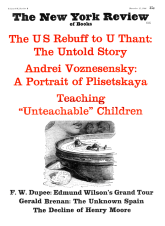In response to:
Art at the End of its Tether from the June 23, 1966 issue
To the Editors:
…Nothing could be more pleasing to an author than to have as reviewer so distinguished a scholar as E.H. Gombrich, and to receive from him so intelligent, sympathetic, and generous a review of a contentious book [Man’s Rage for Chaos: Biology, Behavior, and the Arts, NYR, June 23].
To be sure, Professor Gombrich makes a few errors in his account of what I say. It is not true that my “search of what he calls ‘primary signs’ ” was “stimulated…by the experiments of abstract art.” I am not “unaware of the tradition that reaches back from Kandinsky to the Romantic painter[s].” (It is always unwise to accuse an author of ignorance of something he has not mentioned.) I cannot be attacked by the assertion that “Moreover—and this is decisive—there is a vital difference between stylistic drift and a desire for change,” since this is the point at which I begin and which is the basis for all that follows. It is not true that my theory cannot account for “ritualistic” cultures in which stylistic change is slow; it can, and does; ritual belongs to the semantic aspect of art, and from my theory one would predict that in a ritualistic culture stylistic change would be slow, as Professor Gombrich says….
The source of these errors, and of my reviewer’s failure to understand me, seems to come first from his belief in the correctness of his statement, “If he were entirely right that the sole function of art is to teach us how to cope with unsettling experiences, there would be no point in ever returning to a work of an we have encountered before.” I do no say that that is the sole function of art I say that the defining attribute (not the sole attribute) of artistic experience in exposure to perceptual disorder. After all, more than a third of the book is devoted to the meaning of art, which is not a defining attribute; any semantic function in art can be found outside of art Further, if Professor Gombrich had fully grasped my position he would never have drawn his conclusion “that there is no point,” etc. Works of art do, however, wear out for us, and my theory can explain both how and why, and how and why we can renew them.
His failure to understand me appears to arise from his making an assumption for which there is no basis in the book. He says, “It is clear from the whole tenor of the book that it was his encounter with contemporary avant-garde art that gave the author this shock of disorientation that set him in search of a new and significant problem,” and later, “[he tries] to justify the ways of art to man by inventing a new theory that fits the contemporary scene.” Actually the theory, for whatever it is worth. started from utter dissatisfaction with the traditional descriptions and explanatrons of English prosody for the phenomenon of stress in traditional English poetry, and with the traditional discussions of “form” and “style” in painting and music before 1900. Anyone who understands my theory, including my undergraduates, realize that from it one would arrive at the conclusion that contemporary art probably will lack durability because it offers too little perceptual disorder, not because it offers too much. Indeed, it could be argued that my reviewer’s error supports my position, for it suggests that the theory I offer can explain contemporary art in a way that traditional theories cannot.
This error about my intention is responsible, I think, or at least immediately responsible, for Professor Gombrich’s failure to grasp the real nature of my argument; whether or not it is capable of standing up under criticism, anyone who wishes to demolish it—most critics and aestheticians—must first understand it. But perhaps an ultimate difficulty for Professor Gombrich is that he is interested in art. I am not; I am interested in behavior. My real hope is to enable people to play the role of art-perceiver so well that they do not have to play it so often; it is to damage that mindless adulation of art which David Levine has so exquisitely caricatured.
But in spite of all this, I am grateful to Professor Gombrich for his courtesy and for his praise of what he felt he could praise, as well as for his own admirable book, Art and Illusion, which is one of the rocks on which I have built my wilderness chapel.
Morse Peckham
University of Pennsylvania
Philadelphia
E. H Gombrich replies:
I am grateful to Professor Peckham for his courteous letter. I think my very fully annotated copy of his book would at least convince him that I have tried hard to understand it. If I have nevertheless failed to grasp some of his arguments I can only express the hope that this failure will help him to formulate his hypothesis more clearly in a subsequent book.
This Issue
November 17, 1966



